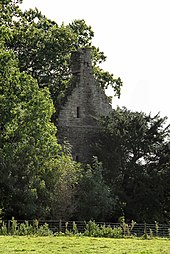

Inchaffray Abbey was situated by the village of Madderty, midway between Perth and Crieff in Strathearn, Scotland. The only traces now visible are an earth mound and some walls on rising ground which once (before drainage) formed an island where the abbey once stood (the surrounding marshes known for eels).
History

Folk etymology has the name Inchaffray taken from the Gaelic innis abh reidh (island of the smooth water), but the earliest attested form of the name is the Latin Insula missarum (island of the masses), mass in Gaelic being oifrend and Welsh offeren, thus island of the offerings. A charter of Jonathan, Bishop of Dunblane, refers to the place "qui uocatur lingua Scottica Inche Affren" (="which is called in the Gaelic language Inche Affren") and comparative usage shows that Insula Missarum was taken as a translation, e.g. "Sancti Johannis evangeliste de Inchefrren" and "sancto Johanni apostolo de Insula Misserum".
A priory was created on the site of an existing ecclesiastical establishment of a group of clerics known as "the brethren of St John of Strathearn". Gilbert, Earl of Strathearn and his first known wife Maud d'Aubigny, daughter of William d'Aubigny (Brito) erected the priory in 1200 in memory of their first-born son Gilchrist, was buried there in 1198. The old religious community was absorbed by the new foundation.
Dedicated to the Virgin Mary, and John the Evangelist, the abbey was granted to the Augustinians of Scone Abbey. The charter survives, granting the churches of Saint Cathan of Abruthven, Saint Ethernan of Madderty, Saint Patrick of Strogeith, Saint Makkessog of Auchterarder, and Saint Beanus of Kinkell. The details of the earlier establishments are not certain, but a church dedicated to John the Evangelist is attested in about 1190. The priory became an abbey in 1221.

Inchaffray was patronised both by the Earls of Strathearn and by the Scottish kings. In 1275 a tithe of real income was assessed on all religious houses to fund a crusade, at which time Inchaffray had an income of 246 pounds per annum, fourth among Augustinian houses, exceeded only by St Andrews, Scone and Holyrood. In time the abbey's lands and dependent churches stretched across Scotland, as far away as Uist in the west and Balfron in the south. The abbey ordered the digging of the Pow of Inchaffray, a nine-mile drainage ditch, to improve nearby marshland.

Abbot Maurice of Inchaffray carried the relics of Saint Fillan to bless the Scots army before the Battle of Bannockburn in 1314. Commendatory abbot Laurence Oliphant, who came from a notable Strathearn family, was killed at the Battle of Flodden in 1514.
By 1561 Inchaffrey's fortunes had declined, its income being assessed at £667, third lowest of the Augustinian abbeys in Scotland included in the levy. With the Scottish Reformation under way, Inchaffray had been turned into a secular lordship for a member of the Drummond family in 1556. James VI visited James Drummond at Inchaffray on 5 October 1601. The property later passed to the Earls of Kinnoull. Much of what remained of the abbey was destroyed in 1816 when a road was driven across the site.
Today a single gable-end wall stands in private property, although it is visible from the road. The ruins are designated a scheduled monument.
Burials
See also
- Abbot of Inchaffray, for a list of priors, abbots and commendators
Notes
- ^ "Inchaffray Abbey", Canmore
- Inchaff. Liber, no. 10.
- Inchaff. Liber, no. 1.
- Inchaff. Liber, no. 2.
- Ewart et al., p. 471
- British Museum Collection
- Sim, Philip (24 October 2018). "Dull as ditchwater - or a best-kept secret?". BBC News. Retrieved 8 January 2019.
- John Mackie, Calendar State Papers Scotland: 1597-1603, vol. 13 (Edinburgh, 1969), p. 879.
- Historic Environment Scotland. "Inchaffray, abbey and early monastic site (SM3200)". Retrieved 15 February 2019.
- Cokayne, G.E. (2000). Complete Peerage of England, Scotland, Ireland, Great Britain and the United Kingdom. Sutton Publishing Co. pp. XII/1:383–4.
References
- Lindsay, William Alexander, & Thomson, John Maitland, (eds.) Charters of Inchaffray, Publications of the Scottish History Society, vol. LVI, (Edinburgh, 1908)
- Watson, W.J., The History of the Celtic Place-names of Scotland. Reprinted with an introduction by Simon Taylor, Birlinn, Edinburgh, 2004. ISBN 1-84158-323-5
- PSAS, volume 126: "Inchaffrey Abbey: Excavation and Research 1987" by Gordon Ewart et al., pp. 469–516.
External links
56°23′2″N 3°41′49″W / 56.38389°N 3.69694°W / 56.38389; -3.69694
Categories:- 13th-century church buildings in Scotland
- Listed monasteries in Scotland
- Augustinian monasteries in Scotland
- Christian monasteries established in the 1200s
- 1556 disestablishments
- History of Perth and Kinross
- Category B listed buildings in Perth and Kinross
- Scheduled monuments in Perth and Kinross
- Former Christian monasteries in Scotland